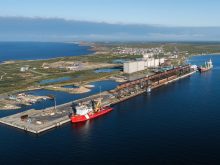Cattle futures surged last week on news of fewer than expected cattle in American feedlots, but Canadian market analysts don’t see a supply problem developing soon.
Brian Perillat, manager and senior analyst at Canfax, said the U.S. cattle-on- feed report, a healthy export picture and strong packer margins drove the recent rally, but he doubts that February and December prices will average about $1.20 as the current futures market suggests.
“If you look really far out, these futures prices seem phenomenally high,” Perillat said. “Maybe under good conditions, we may hit that as a peak. We saw that in the spring. But to say we’re going to average that over an entire quarter, we’ve never seen that.”
Read Also

Agriculture ministers commit to enhancing competitiveness
Canadian ag ministers said they want to ensure farmers, ranchers and processors are competitive through ongoing regulatory reform and business risk management programs that work.
The futures rally seemed to feed off supply concerns when the United States reported a four percent increase in cattle on feed, compared to the expected 5.4 percent increase.
Also, the number of cattle put on feed in May fell 11 percent from last year to 1.81 million.
That indicated reduced supplies in the third and fourth quarters, and futures prices rose about 4.5 percent in the following three days.
But Perillat believes the high prices will help reduce the supply problem.
“Supplies are not going to be as tight as they would expect just because there’s a lot of cattle out there that could get pulled forward and move into these spots that are offering such high price premiums,” said Perillat.
“We’re looking at pretty big supplies come this summer, especially in the U.S.”
Despite the smallest U.S. calf crop in about 50 years, more cattle are going to market because of better prices and southern U.S. drought
“The drought in the U.S. and Mexico brought a whole bunch more cattle onto feed as well, so that actually did pull cattle forward, and those are the cattle that are going to be hitting us in the third quarter.”
Perillat said recent cattle markets are incredibly volatile. The responses of commodity fund managers to livestock reports make the market harder to predict, he added.
Also, consumers have less disposable incomewhen fuel prices rise, which lowers meat purchases.
“Will consumers pay up to make these high prices sustainable throughout the whole beef supply chain for the packers and the wholesalers to actually achieve the prices they need, at the retail level, to sustain $1.20 fats or whatever we’re looking at into the fourth quarter?” he said.
Healthy beef exports this year are also fuelling the market, as are strong U.S. packer margins.
Futures markets will watch corn price’s effect on feeder margins.
Barley is often the feed of choice in Canada, but barley production has dropped in recent years. However, wet weather and a late seeding start may have encouraged more barley plantings, and there could also be a good supply of feed wheat.
“Price wise, we are at a fairly big advantage over the U.S.,” said Perillat. “Our feed costs are a lot lower than the U.S. Our spread between Canada and the U.S. gives us a lot bigger advantage than we’ve had probably in the last few years.”















